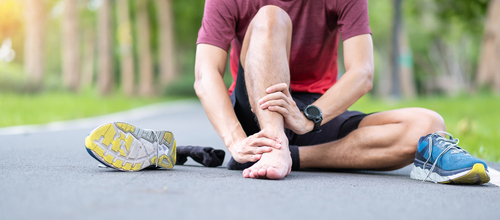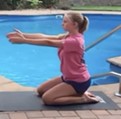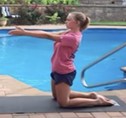[Core] Chiropractic and Wellness
CoreRoanoke.com
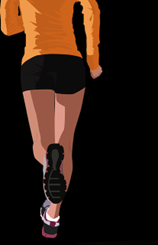 Running injuries are a common topic around our office. Achilles tendonitis is a common running injury that affects the Achilles tendon, the largest tendon in the human body. It connects the calf muscles to the heel bone and is responsible for the pushing movement of the foot and ankle. Achilles tendonitis occurs with overuse or repetitive strain on the tendon, resulting in tiny tears in the tendon fibers. When this occurs the tendon becomes inflamed, causing pain and discomfort. In this newsletter, we will discuss the causes of Achilles tendonitis and the treatment options available, including chiropractic, acupuncture, Active Release Technique, and rehabilitative exercises.
Running injuries are a common topic around our office. Achilles tendonitis is a common running injury that affects the Achilles tendon, the largest tendon in the human body. It connects the calf muscles to the heel bone and is responsible for the pushing movement of the foot and ankle. Achilles tendonitis occurs with overuse or repetitive strain on the tendon, resulting in tiny tears in the tendon fibers. When this occurs the tendon becomes inflamed, causing pain and discomfort. In this newsletter, we will discuss the causes of Achilles tendonitis and the treatment options available, including chiropractic, acupuncture, Active Release Technique, and rehabilitative exercises.
Causes of Achilles Tendonitis
Achilles tendonitis is typically caused by overuse or repetitive stress on the Achilles tendon. This can occur in athletes who engage in activities that require running and jumping, such as basketball, soccer, and tennis. It can also occur in individuals who engage in physical activities that put stress on the Achilles tendon, such as dancing or jumping. Other causes of Achilles tendonitis include:
***Tight calf muscles: Tight calf muscles can put additional stress on the Achilles tendon, leading to inflammation and pain.
***Incorrect footwear: Wearing shoes that do not fit properly or do not provide adequate support can put additional stress on the Achilles tendon.
***Age: As we age, our tendons become less flexible and more prone to injury.
***Foot structure: Flat feet or high arches can put extra strain on the Achilles tendon, increasing the risk of injury.
***Intense physical activity: Athletes who engage in activities that involve jumping or sudden changes in direction are at higher risk of developing Achilles tendonitis.
***Medical conditions: Certain medical conditions, such as obesity, diabetes, and arthritis, can increase the risk of Achilles tendonitis.
***Medications: Some medications, such as fluoroquinolone antibiotics, have been linked to an increased risk of tendonitis.
***Training errors: Poor training techniques or sudden increases in training intensity or duration can also increase the risk of Achilles tendonitis.
Treatment Options
- Chiropractic:
Chiropractic care is a non-invasive treatment option that focuses on the musculoskeletal system. We use many different manual techniques to manipulate the joints and soft tissues of the body to relieve pain and improve function. For Achilles tendonitis, I like to use spinal adjustments to improve the function of the pelvis and low back. This helps to improve the body posture and relieve soft tissue stress on the Achilles tendon.
- Acupuncture:
Acupuncture is a traditional Chinese medicine technique that involves inserting thin needles into specific points on the body to stimulate healing. For Achilles tendonitis, acupuncture can be used to increase blood flow and promote healing of the inflamed tendon. A mixture of needling both the acupuncture points of the foot and dry needling the Achilles tendon itself is very successful in reducing both pain and time off from training.
- Active Release Technique:
Active Release Technique (ART) is a soft tissue therapy that is used to treat injuries to muscles, tendons, ligaments, and nerves. ART involves applying pressure to the affected area while the patient moves the joint through a range of motion. This technique can be effective in treating Achilles tendonitis by breaking up scar tissue and promoting healing. I find that using ART in combination with chiropractic adjusting of the pelvis and feet to be an extremely useful treatment in reducing the pain with Achilles tendonitis.
- Rehabilitation Exercises:
Physical therapy exercises can help to strengthen the muscles and improve the flexibility of the calf muscles and Achilles tendon. Attention should also be made to increase the mobility and power that the hip muscles produce. This decreases the load placed on the calf muscles and improves the efficiency of the lower extremity.
LUNGE VARIATIONS
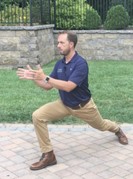
There are many different variations on the lunge. Lunges can be a great way to take the hip through a large and controlled ROM while increasing the strength and flexibility of the ankle. In this video I demonstrate my favorite lunge variation, the clock lunge.
This exercise can be performed by kneeling on one leg. Slightly open your stance with the other leg’s foot flat on the ground. With a small oblique angle sit backwards through the hip, travel down and back as far as you feel comfortable and then return to the kneeling position. Repeat this 5-10X per leg. This exercise can be found on our YouTube channel by following the link here.
Kneel on both knees with your spine and posture as tall as possible. Maintain good posture while you sit back towards your feet and rise back up again. The hinge will target the muscles surrounding the hip joint that become weak very easily with prolonged sitting. Repeat this 10-15X. This exercise can be found here.
Conclusion
Achilles tendonitis is a common condition that can be caused by overuse, incorrect footwear, tight calf muscles, age, and obesity. Treatment options for Achilles tendonitis include chiropractic, acupuncture, active release technique, and rehab exercises. These treatments are non-invasive and can be effective in relieving pain, reducing inflammation, and promoting healing of the Achilles tendon. If you are experiencing pain or discomfort in your Achilles tendon, it is important to seek attention to determine the underlying cause and develop an appropriate treatment plan. It is our goal at [Core] to partner with you in all of your health needs to see you become healthier than you have ever been.

